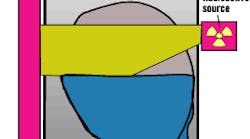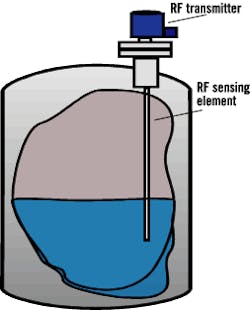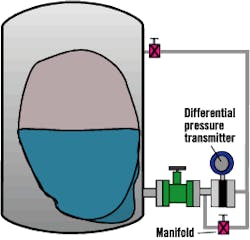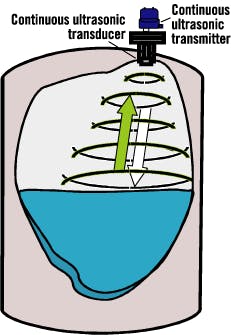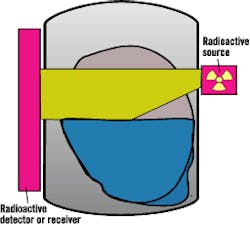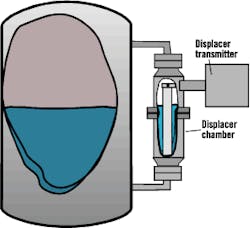People have been using various devices to measure level since about 3000 BC. The first historical references to a measuring device were dipsticks or staff gauges used to indicate the amount of water stored in reservoirs for farming. Next came crude float-type devices to indicate the height of drinking water reserves in underground cisterns or storage caverns.
Modern instrumentation uses more than 20 different technologies to satisfy the ever-growing requirements for level measurement in a wide variety of applications. Some instruments measure level directly, while others measure some other variable that is related to level. Direct-measurement instruments include sight glasses, dipsticks and floats. Indirect-measurement devices include differential pressure, sonic, nuclear and radio frequency (RF).
Point vs. continuous
Level measurement instrumentation can be divided into two major types, point level and continuous level devices.
Point level (on/off) measurement devices indicate the absence or presence of a material at a certain point within a vessel. Point level switches are used as high-level and spill prevention alarms and low-level and pump protection alarms, as well as to turn pumps on and off.
Continuous level (proportional) measurement devices indicate the level in a vessel over the full span of measurement. These devices typically are used for process control, inventory control and management.
Technologies used to measure both continuous or point level are affected differently by varying process conditions. Factors such as pressure, temperature, agitation, corrosion, foaming and explosion hazards need to be considered before device selection. Other conditions that affect level measurement are a material's density, chemical composition, buildup and electrical properties.
RF Capacitance Device
Level measurement technologies
Many technologies currently are in use.
Bubblers (continuous)
. Perhaps the simplest devices currently available, bubblers measure backpressure by forcing gas (air) down into an immersed vertical pipe until gas bubbles emerge. That pressure is related to the change in the height of the liquid in the vessel, as well as density.Bubblers ignore foam and provide excellent performance in continuous level measurement of thin fluids, both conductive and insulating. However, they require a high degree of maintenance and need a clean gas supply.
Capacitance/RF devices (point level or continuous)
. RF admittance is by far the most versatile level measurement technology, good for a wide range of conditions, from cryogenics to high-temperature and from vacuum to 10,000-pounds-per-square-inch (psi) pressure. It works with virtually all types of materials.RF current from constant voltage applied to one electrode measures the impedance change between two capacitor electrodes (often a single electrode and the vessel wall, or the material itself and the insulating coating on the sensor), based on rise and fall of material in vessel. A second sensor to monitor dielectric can provide compensation.
RF devices feature excellent performance with thin fluids and for measuring interfaces, and perform fairly well to excellent in thick fluids and slurries. They can ignore organic foam, but can measure both aqueous and organic foams.
Switches generally are very good for powdery, chunky or sticky solids, but continuous measurement versions are more limited in this area. Continuous measurement versions also cannot measure the interface between conductive layers or between liquids and solids. With point level switches, conductive coatings can produce a false high without a guard-type probe, and short insertions can be a problem.
Conductivity switches
. This technology recognizes that the resistance between two probes, or a probe and vessel wall, is significantly higher in air than in conductive liquid. When conductive liquid is brought into contact with the probe, the drop in resistance being measured between the two will change the output status.Conductivity switches work very well with conductive thin fluids and perform fairly well in detecting interface. However, they are of limited use for thick fluids and slurries or solids. They can detect conductive process materials, but thin insulating coatings produce false lows while conductive thick fluids can show false highs. Conductivity switches ignore organic foams but can measure aqueous foams.
Diaphragm devices
. The use of immersed sensor measurement in nonpressurized vessels is quite straightforward, using a single measurement of head pressure. When corrected for density, the measurement is equal to liquid level.Diaphragm continuous measurement instruments are of limited use in thin fluids. They perform fairly well in thick fluids and will ignore foam. Submerged sensors need a reference to atmospheric pressure. Switches are used infrequently and are suitable for granular solids only.
Differential Pressure Device
Differential pressure devices
. Perhaps the most frequently used instruments, differential pressure devices measure the head pressure at the sensor location resulting from the height of the process material multiplied by density. Continuous measurement versions are excellent choices for the continuous measurement of both thin and thick liquids and ignore foam. However, they require diaphragm seals, repeaters, purging or sealing legs to prevent slurry-related plugging. Point level switches are limited to clean liquids with constant specific gravity.Displacer devices
. Displacer devices are based on Archimede's principle: "When a body is immersed in fluid, its weight loss is equal to the weight of the fluid displaced." A heavy body (displacer) is suspended in fluid, often in a side chamber, and is buoyed up in proportion to the fluid level multiplied by density.Continuous measurement versions are excellent choices for the continuous measurement of thin fluids, but perform only fair in locating interfaces and are of limited use for thick fluids. They ignore foam. Point level switches perform excellent in thin fluids, but only fair in thick fluids and in locating interfaces. Neither is recommended for sludge or slurries, and vacuum and/or a high viscosity can cause dynamic instability.
Float devices
. Perhaps the oldest method and the easiest to understand, float technology is available in many versions that also can be connected to micro switches, mercury switches or even pressure switches. Continuous measurement float devices are excellent choices for continuous measurement of thin fluids, but are of limited use for interfaces and thick fluids. They ignore foam, but can be used to measure it. Point level switches perform only fair with thick fluids. Their moving parts limit most designs to clean service, and only density-adjusted floats can detect interfaces.Laser devices (non-contact)
. With laser devices, a laser beam is reflected from the material's surface, and the time lag to read the reflection bouncing off the material is proportional to the space above the level. Laser devices are excellent choices for continuous measurement of thick fluids, chunks and sticky solids. However, they are of limited use with thin fluids, powders, locating interfaces and foam.Magnetostrictive devices
. These devices incorporate Ferro-magnetic wire inside a non-magnetic sensing tube with a movable magnetic float outside the sensing tube. A current pulse sent down the wire interacts with the magnetic field of the float, producing a torsional strain pulse on the wire. The pulse travels back up the wire from that point at a known speed, interacting with a device that produces electrical pulse. The time interval between the initial pulse and the return of strain pulse is converted into 4-20-mA output proportional to level.Magnetostrictive devices work extremely well for continuous measurement of thin fluids, but are of limited use for thick fluids. They ignore foams and can be used with a density-adjusted float to locate interfaces.
Continuous Ultrasonic Device
Microwave switches (non-contact)
. With microwave switch technology, a pulsed microwave signal is radiated by a directional antenna. A directional antenna receiver compares the two signal strengths to determine the level above or below a set threshold-to-trip switch.Microwave switches are excellent choices for conducting fluids and detecting interfaces, but are of limited use with insulating fluids and powders and chunks. They ignore organic foams and can measure aqueous foams. Fluids with a low dielectric constant and thick coatings are a problem; microwave signals are absorbed almost entirely by water, causing problems with products that are water-based or contain water.
Radar devices (non-contact)
. With radar technology, a strong frequency modulated continuous wave (FMCW) signal allows accurate reading of the echo bouncing off the material. The time for return is proportional to level. The strength of the signal also requires plants to meet specific installation criteria to comply with Federal Communications Commission regulations.Radar devices do an excellent job in the continuous measurement of conducting fluids, aqueous slurries and powders. They are of limited use with insulating fluids, aqueous foam and chunks or sticky solids. Low dielectric materials limit their range, and condensation or crystallization on antenna can cause errors.
Radiation devices (nuclear) (can be non-contact)
. Radiation level technology requires a radioactive source(s) to be mounted on one side of the vessel and radiation detector(s) to be mounted on the opposite side. The high-energy signal penetrates the vessel walls and shoots through the material. The amount received by the detector is dependent on level and density. This technology's big advantage is that the vessel is not penetrated.Continuous measurement radiation devices are excellent choices for continuous measurement of most fluids and solids; however, they are of limited use in aqueous foams and slurries. As switches, radiation devices are of limited use in detecting interfaces and with aqueous slurries. They can ignore foams, but can measure them. To use the devices, plants must obtain a Nuclear Regulatory Commission license. Source disposal can be a problem, and heavy coatings can limit reliability.
Radiation Device
Resistance tapes
. With this technology, resistor wire is helically wound around steel tape mounted vertically in a vessel. The pressure of the fluid causes the tape to be short-circuited, changing the total resistance in direct relation to level.Resistance tapes do an excellent job in the continuous measurement of thin fluids, but have only limited use with thick fluids. They perform only fair in aqueous slurries. They will ignore foams, but have limited temperature and pressure ranges and are adversely affected by large specific gravity changes.
Rotating paddle switches
. This technology has a low-power synchronous motor that keeps the paddles moving at a low speed and stops when the material stalls the paddles. A change in motor torque triggers the switch.Rotating paddle switches are excellent choices for powders, but perform only fair with chunks of solids. They are limited to the detection of dry, noncorrosive low-pressure solids.
Sight gauges
. Glass gauges are for nonaggressive process applications at moderate temperatures and pressures. If a process is clear, a reflex-type gauge can be used to create a visual indication. In more aggressive conditions in which glass is not suitable or acceptable, a magnetic float type can be used and linked to an outside tracking component.Sight gauges boast excellent performance with thin fluids, but are of only limited use for interfaces, thick fluids and foams. They must have the same temperature as the tank. Foam and boiling are potential problems; opaque coatings cause incorrect readings.
Displacer Device
Tape floats (& servos)
. With tapes floats and servos, a plumb bob (or yo-yo) is a weight lowered by a motor until it "lands" on the surface of the material, changing tension in the wire, which stops the motor. The length of wire used indicates the space of material encountered. Measurement is independent of density, moisture and granular size.Tape floats are excellent choices for the continuous measurement of thin fluids. They have limited use with thick fluids. Tape floats can ignore foams. A servo plumb bob is suitable for solids and interfaces, but mechanical hang can be a problem.
Thermal dispersion devices
. With this technology, a self-heated thermistor (negative-temperature-coefficient resistor) changes resistance as the heat dispersion changes with the change in exposure to the fluid (as the level changes in the vessel, or the fluid reaches the sensor).Thermal dispersion devices work very well with thin fluids, and are fair choices for thick fluids. They ignore foams, but can measure them. Foam detection is limited by thermal conductivity, and interface detection is limited by differential thermal conductivity.
Time domain reflectometry (TDR) devices
. This guided electromagnetic wave method uses a rigid or flexible probe (or sometimes two probes). The electromagnetic field is focused into a tight beam by traveling along rod(s) or a cable. This focused beam makes the technology better suited to granular service without the need for high levels of microwave associated with FMCW radar.TDR is an excellent choice for the continuous measurement of thin fluids and for conducting thick fluids, aqueous slurries, powders and solid chunks. It has limited application for sticky solids and locating interfaces. TDR ignores organic foams and can measure aqueous foams. Long nozzles are a problem, and the range and accuracy on insulating material is greater with a high dielectric constant. The technology can have significant "dead zones," depending on mounting.
Ultrasonic (non-contact) devices
. Ultrasonic gap switches have one crystal electrically resonating at a certain frequency that generates sound waves. The sound waves travel across air gap toward the second crystal. As material fills the gap, the sound has a better medium to travel, causing a second crystal to resonate with the first. The continuous version sends a very high-frequency sound wave from a transmitter to the contents of the vessel and measures the length of time it takes for that signal to return to the transducer.Ultrasonic devices perform excellently with thin fluids and ignore foam. Continuous measurement versions are fair choices for thick fluids, but switches are limited in that application. With continuous measurement versions, dust and dew in the vapor space hurt performance, and the range is limited by foam and angled or aerated solids. With switches, air bubbles and solid particles in the liquid will produce a "low" signal.
Vibrating switches
. With this technology, a tuning fork vibrates tines or paddles at a specific frequency, which is dampened when the material reaches it.Vibrating switches are excellent choices for powders and chunky solids, and fair choices for thick fluids. They are of limited use with thin fluids. Vibrating switches ignore foam. Excessive material buildup can prevent operation, and the devices are sensitive to mechanical shock.
Conclusion
A variety of technologies are available to meet most users' level measurement applications. However, the topic is far more complex than the brief generalizations here. Users also must consider factors such as locating interfaces between materials, sensor combinations and mounting positions.
Look for a solution, not a just technology. And remember: A newer technology does not necessarily mean a better technology for your application.
The table on page 39 attempts a summary of currently available technologies and also offers some suggestions regarding use. However, no good decision is based on a "magic formula." To choose correctly, talk to your level instrumentation provider about your specific application. CP
Herb works for AMETEK Drexelbrook in Horsham, Pa. He is the author of textbooks and courses for ISA, and also has written numerous instrumentation-related articles. Contact him at [email protected]. Some of the material in this article was made available through the help of John Roede, Don Koeneman and Bill Sholette, all of Drexelbrook.
